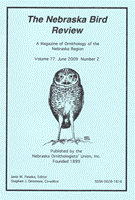Nebraska Ornithologists' Union

Nebraska Bird Review
Date of this Version
6-1991
Document Type
Article
Citation
Nebraska Bird Review (June 1991) 59(2).
Abstract
Atwood (1986) described nocturnal communal roosting by the California Least Tern (Sterna antillarum browni). Such behavior has not been described in other Least Tern subspecies (Whitman, 1988).
Nocturnal roosting by Interior Least Terns (Sterna antillarum athalassos) was observed on each of three evenings between 23 and 31 May 1989 and once on 15 May 1990 when we observed a known nesting location. Least Terns congregated immediately before sunset and started flying in pairs or small groups with much vocalization. Occasionally all birds joined into one compact flock exhibiting synchronized flight as observed by Atwood (1986). With fading light, the birds joined in synchronized flight and made one to three low sweeps over the roosting area with individuals dropping out to land on each sweep. Least Terns were spaced from 0.3 to 1.0 m apart in the roosting area within loose groups. Upon landing birds began preening with continued vocalization. Approximately 1 to 2 minutes after the last bird landed, vocalizations and preening ceased. Silence and inactivity continued past dark. Examination of the roost in daylight revealed evenly spaced scrapes in the substrate. Least Terns were also observed roosting in depressions made by tire tracks within the roosting area.
Our observations of night roosting were at a group of inactive sand and gravel pits near Elm Creek, Buffalo County, Nebraska (NE¼, N½, sec. 16, R1SW, T8N). The roosting area was located in a depression 42 m by 70 m, with the outer rim ranging from 0.25 to 1.5 m above the depression floor. The floor was relatively level and had a predominantly gravel substrate. The roost site may have afforded some degree of wind protection. Nesting occurred at other sites within the sand pit complex, but not within the area used for nocturnal roosting. Nests were located on sandy substrates, 115-460 m from the roosting location.


Comments
Copyright 1991, Nebraska Ornithologists' Union. Used by permission.